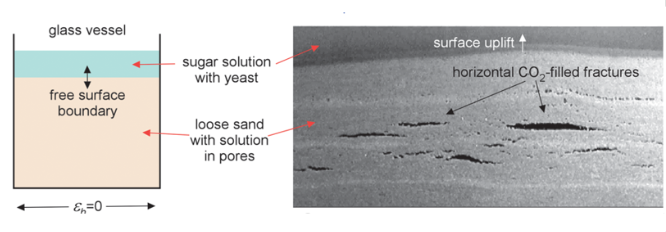The dynamics of fluid supported dense granular flows: A new view on how rock-fluid mixtures impact earthquake occurrences
- Academic lead
- Sandra Piazolo, School of Earth and Environment, S.Piazolo@leeds.ac.uk
- Co-supervisor(s)
- Ali Hassanpour, School of Chemical and Process Engineering, a.hassanpour@leeds.ac.uk, Sam Pegler, School of Mathematics, S.Pegler@leeds.ac.uk, Arash Rabbani, School of Computing, A.Rabbani@leeds.ac.uk
- Project themes
- Environmental Flows, Geophysical and Astrophysical Flows, Industrial Processes, Underpinning Methods for Fluid Dynamics
This project will address fundamental aspects of fluid-dense granular flow giving rise to the evolution of a complex micro- to mesoscale structures in the material, eventually informing efforts to predict the dynamics of rock flow in earthquake prone areas, such as plate boundaries, and implication on the occurrence of “Big Ones” (earthquakes of high energy release, e.g. Fukuyama Earthquake 2011 and associated tsunami), a problem of high societal importance.
Geophysical observations over the last two decades have shown that our view that rocks flow dominantly either frictionally or viscously is not sufficient. Current models neglect the key rheological effects introduced by the presence and influx of fluids in rocks under stress. Recent work shows that beneath earthquake prone areas rocks flow as fluid – dense granular mixtures developing a highly dynamic system of episodic fluid overpressure (Figure 1), pressure release and fracturing (Figure 2), fast slip through lubrication and jamming with frictional sliding. This realization of the importance of fluid presence in the deformation of the Earth opens up exciting research opportunities in fluid dynamics to be addressed in this project. The project presents a variety of exciting directions, including analogue modelling utilizing modified experimental apparatuses and/or numerical modelling of fluid-granular materials. Both approaches will have to be underpinned by the fundamental mathematics of fluid-granular material interaction with regime and instability analysis. The particular focus of the project will be tailored to the interests of the student.
The project is highly timely, with the opportunity to develop new methods addressing a key open problem in the field, promising publications in high-impact journals.
 Figure 1: Experimental analogue model of a fluid-gas-granular mixture with constant gas production (fluid is sugary water mixed with yeast (which produces gas)), granular material is sand grains. Note fluid escape structures. This is done under static conditions, but what happens under shear? (after Bons & van Milligen. Geology, 29, 919-922)
Figure 1: Experimental analogue model of a fluid-gas-granular mixture with constant gas production (fluid is sugary water mixed with yeast (which produces gas)), granular material is sand grains. Note fluid escape structures. This is done under static conditions, but what happens under shear? (after Bons & van Milligen. Geology, 29, 919-922)
 Figure 2: Image of Fluid escape structures within rocks that have undergone high strain rate shear at high fluid pressures and high confining pressures. Pacific, Island of New Caledonia.
Figure 2: Image of Fluid escape structures within rocks that have undergone high strain rate shear at high fluid pressures and high confining pressures. Pacific, Island of New Caledonia.
